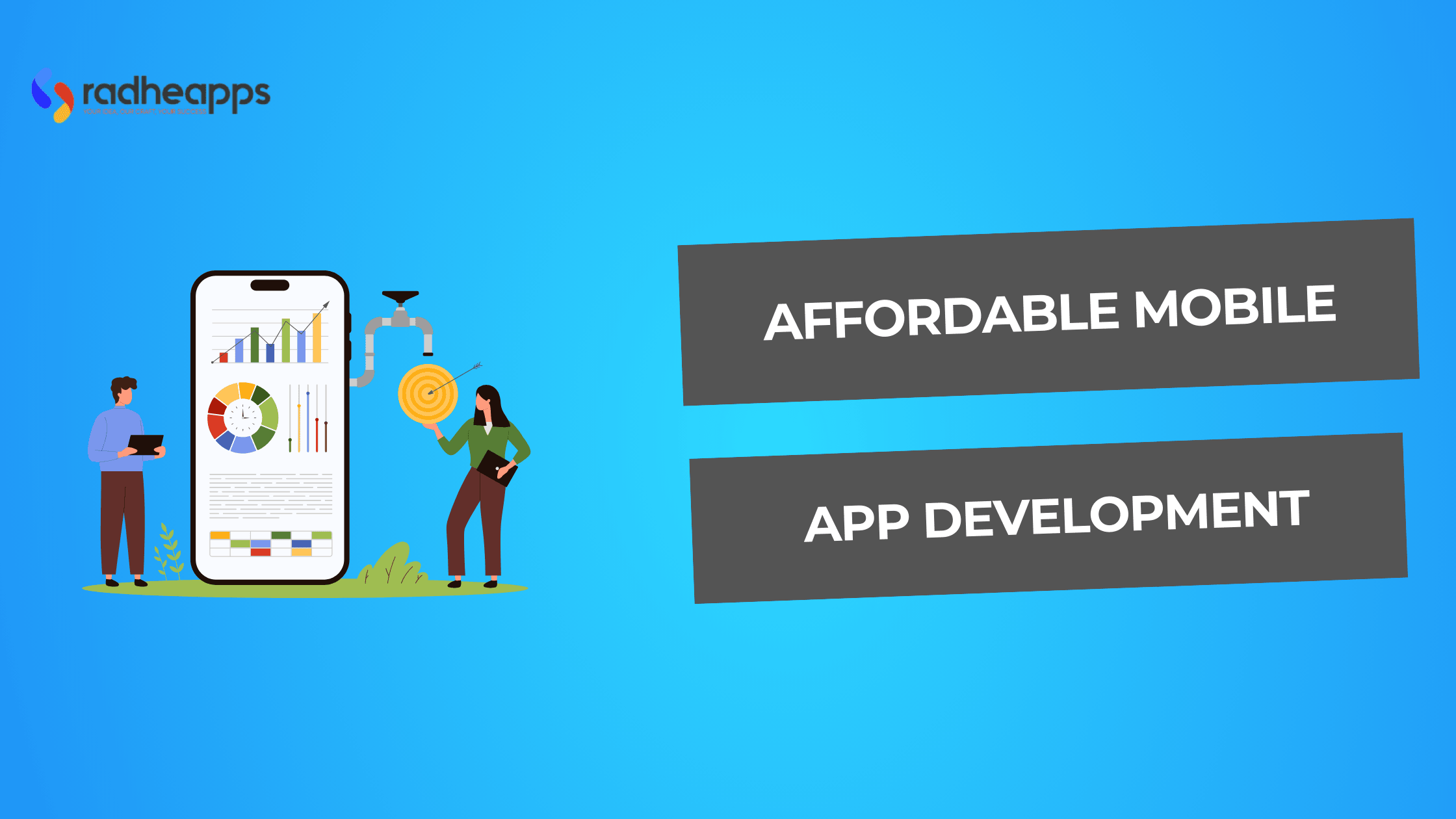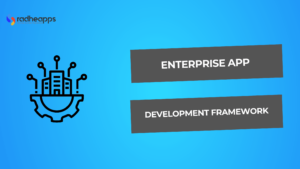Imagine your business analytics show a low customer engagement rate. Each of your business processes has become complicated, and on top of that, your competitors are way ahead. This becomes reality when the market demands a mobile app and the business ignores it.
Nonetheless, the exorbitant cost of mobile app development can be a major challenge, particularly for small and medium-sized businesses. Hence, it is important to find budget-friendly alternatives without sacrificing quality. This is where we come into the picture. Radheapps develops apps that look premium without the price tag.
This trait of affordability led us to be recognized and referred by global brands. Our developed apps have increased our clients’ conversion by 94%. Our agile process helps us deliver quality applications on time, so you will not face any launch delays.
Connect with us on a consultation call to differentiate yourself in a market flooded with AI apps that lack authenticity.
Why Businesses Need Cost-Effective Mobile Apps?
Cost-effective mobile apps are a strategic tool and act as a customer engagement for businesses. Here are six reasons to prove this:
Improved Customer Engagement:
- Direct Communication: Apps allow for direct customer communication via push notifications, updates, and custom messages, keeping customers interested and loyal.
- Higher Interaction: Customers interact more often with apps than websites, increasing retention rates and stronger relationships with the brand.
More Sales Opportunities:
- Convenience: Apps give users an effortless shopping experience, enabling them to browse and buy products easily, which can translate to higher sales.
- Personalized Marketing: With the analysis of user behavior, companies can make marketing efforts more personalized to individual tastes, increasing the success rate of promotion campaigns and rising conversion rates.
Operational Efficiency:
- Simplified Processes: Mobile applications have the ability to automate business functions, which minimizes manual work and increases general efficiency. This enables staff to concentrate on more strategic functions.
- Real-Time Data Access: Staff can access real-time data via mobile applications, enhancing decision-making and organizational responsiveness.
Cost-Effectiveness:
- Lower Marketing Expenses: Apps are an online marketing platform that can lower dependency on conventional marketing strategies, which results in overall lower marketing costs.
- Development Tactics: The creation of Minimum Viable Products (MVPs) helps businesses lower their development expenses but allows them to adapt their applications through user feedback.
Competitive Edge:
- Market Differentiation: A properly designed mobile application can make a company stand out from others, particularly if they don’t have a robust mobile presence. This is likely to bring more customers who prefer apps to websites for their purchasing requirements.
Long-Term Growth Potential:
- Scalability: Mobile applications exist to match the growth of the business. Additional features and functionalities can be added to mobile applications through updates that extend the investment value as market needs change.
Key Factors That Influence Mobile App Development Cost
The price of mobile application development depends on various major factors that companies need to think about when they are making their projects.
Knowing these factors can assist in budgeting appropriately and making sure the app accomplishes its desired objectives:
App Complexity and Features:
The app complexity and the features it supports are key drivers of development expenses.
- Basic Apps: These have minimal functionalities priced between $5,000 and $20,000. They can support basic elements such as user login and navigation.
- Moderate Complexity Apps: These apps support additional advanced features such as social media integration or payment gateways with prices between $20,000 and $50,000.
- Advanced Apps: Extremely sophisticated apps that incorporate state-of-the-art technologies (such as AR/VR) or have significant backend support can go over $50,000 and often cost as much as $300,000 or more based on the particular functionalities needed.
Platform Selection: Android, iOS, or both:
Platform selection has a huge impact on the total cost:
- iOS Development: Typically more costly because of the strict guidelines and optimization needed for all Apple devices. The cost usually falls between $10,000 and $100,000.
- Android Development: Although frequently a bit lower in price than iOS, Android development can be more expensive in testing because of device fragmentation. Prices also vary between $10,000 and $100,000.
- Cross-Platform Development: Cross-platform development for both at once can be more effective but typically costs between $15,000 and $150,000 because of the extra resources involved.
Design and User Experience Considerations:
The design component is key to determining costs:
- Basic Design: Simple page designs with basic components can be built for approximately $3,000 to $6,000.
- Custom Design: Customized designs that mirror brand identity cost between $8,000 and $30,000.
- High-End Design: High-end designs with sophisticated animations and rich user interfaces may cost over $30,000.
Development Team and Location:
The development team and where they are based may have a strong influence on prices:
- Local vs. Offshore Teams: Organizational benefits from local developers include better communication and quality management although their costs are higher whereas offshore teams deliver lower prices while bringing potential extra work for team coordination.
- Team Expertise: Experienced developers familiar with certain technologies might charge higher fees but can yield improved quality and quicker turnaround times.
How to Find the Right Budget Mobile App Development Partner
To identify an appropriate budget mobile app development partner is important to ensure your project is completed and within budget.
The following are important considerations in choosing a development partner:
Key Qualities to Look for in an App Developer
- Experience and Expertise: Select a developer who demonstrates expertise in mobile app development so they can support platforms including iOS and Android and cross-platform applications. The diverse projects featured in a solid portfolio demonstrate both reliability and the development skillset of a developer.
- Creativity and Innovation: The perfect developer should express creative thinking in app design and functionality. They should know the current trends and technologies to ensure your app stays competitive.
- Good Communication Skills: Good communication is critical to the success of a project. Your developer must be receptive to dialogue, offer frequent updates, and be sensitive to feedback during the development phase.
- Quality Assurance Practices: Confirm that the developer maintains an experienced quality assurance system. A quality assurance process consists of testing practices that ensure the elimination of all bugs before product launch.
Compare Pricing Models: Fixed Cost vs. Hourly Rates
To know the pricing models will allow you to pick the best possible option for your project requirements:
- Fixed Cost Model: The model gives a fixed price for finishing the project based on specified specifications. The model is suitable for projects with clear scopes so that the budget can be managed accurately but there is little room for adjustment.
- Hourly Rate Model: Your costs will depend on the precise number of hours that your company dedicates to the project. This payment method lets projects evolve or develop unclear specifications as the work progresses. The flexible payment method gives project developers more freedom but leads to unpredictable costs because of project complexity and duration.
Check Portfolio and Client Reviews
To assess a developer’s portfolio and client testimonials is crucial:
- Portfolio Review: Review their past work to measure design quality, usability, and user experience. Check for similar apps you plan to create to determine their relative experience.
- Client Testimonials: Collect reviews and testimonials from clients for past work to determine their satisfaction levels and any development issues encountered. Good feedback can reflect the reliability and quality of work.
How to Build an Affordable Mobile App Without Sacrificing Performance
To create a cost-effective mobile application without compromising performance requires strategic planning and wise decision-making.
The following are some effective strategies to attain this:
Choose the Right Technology Stack
The choice of a suitable technology stack is important to manage cost versus performance.
- Native vs. Cross-Platform: The development costs of native applications across multiple platforms (iOS and Android) are unusually high, but these apps perform at peak efficiency.
- The combination of React Native or Flutter technology provides developers with a single codebase solution that maintains performance quality while reducing development expenses across multiple platforms.
- Open-Source Tools: Open-source libraries and frameworks help organizations minimize expenses when used in their development process.
- Developers can use Apache Cordova and Bootstrap to access free solutions that enable them to prioritize distinctive features instead of core functionalities.
Leverage Pre-Built Templates and Frameworks
Employing pre-built templates and frameworks can dramatically lower development time and expenses:
- Templates: Most platforms provide adjustable templates that may be used to suit your requirements. This method quickens the process of designing and provides a professional appearance at an affordable cost, as opposed to custom designs.
- Frameworks: A framework such as Ionic or Xamarin may assist in simplifying development processes, where developers can add typical functionalities promptly without compromising quality or performance.
Outsourcing vs. In-House Development: Pros and Cons
Choosing to outsource development or employ in-house talent is an important decision that impacts the budget:
- Outsourcing: Acquiring offshore developers expands your talent pool access with potential cost benefits, unless you hire employees in regions with low labor costs. The collaboration mode can come with communication issues and different time zones between teams.
- In-House Development: Though this allows for greater control of the project and simpler communication, it usually involves greater costs because of salaries, benefits, and overheads. In-house teams also have restricted expertise versus specialist outsourced teams.
Prioritize Must-Have Features Over Extras
To prioritize must-have features keeps development costs in check while ensuring the app satisfies user requirements:
- Minimum Viable Product (MVP): Begin with an MVP that encompasses only the most important functionalities to address your target audience’s key issue. This lets you launch quickly, get user feedback, and iterate according to actual data without spending too much on extraneous features.
- Feature Prioritization: Categorize features as “must-haves” and “nice-to-haves.” By focusing on essential functionalities first, you will be able to make sure that the app provides value while maintaining initial expenses reasonable.
Best Practices for Low-Cost Mobile App Development
Creating an affordable mobile application without compromising on quality and performance is possible with best practices.
Some of the important strategies to adopt are as follows:
Conduct thorough Market Research
Before starting development, carrying out extensive market research is critical. This entails:
- Determine Your Target Audience: Know who your target users are, their interests, and habits. This assists in making the app meet their requirements optimally.
- Analyze Competitors: Look at current apps within your category and determine their strengths and weaknesses. This comparison may uncover areas in the market where your app can fill a void, making it easier to differentiate your product.
- Validate Your Idea: With market research, you can gauge if there’s a real need for your app. This process is important not to waste resources on an idea that will not appeal to users.
Use the MVP (Minimum Viable Product) Approach
Using the MVP method can greatly save on expenses while providing necessary testing and feedback:
- Prioritize Core Features: Develop an application version containing only fundamental essential features to address the main user issues. The initial development timeline stays short, along with costs, as this approach allows you to launch your product on the market more quickly.
- Iterate Based on Feedback: You must select a developer who brings experience. In mobile app development, together with knowledge of different platforms (iO,S Android cross-platform) and technical competencies. Company reliability, together with development capability, can be assessed through diverse projects that appear in the portfolio.
Implement Agile Development Methods
To use agile development methodologies can improve efficiency and lower costs:
- Flexibility: Agile permits changes during the development process based on feedback and shifting requirements, which can avoid expensive reworks down the line.
- Frequent Updates: Breaking the project into smaller, more manageable pieces allows teams to deliver updates frequently, keeping the app current and usable without overinvesting at the beginning.
Test Early to Avoid Costly Fixes
Early testing is key in catching problems before they snowball:
- User Testing: Run usability tests at multiple development points to identify bugs and usability problems early on. This proactive testing can be much less costly in terms of time and money than debugging later.
- Performance Testing: Verify the app is well-performing in different situations (e.g., different network speeds). Early Performance tests can uncover bottlenecks that would influence user experience later on.
Affordable Cross-Platform App Development Strategies
Cost-effective cross-platform app development can cut expenses substantially without sacrificing quality and performance.
The following are some successful strategies to explore:
Benefits of Cross-Platform Development
- Single Codebase: Cross-platform development enables the developer to use a single codebase that will run on more than one platform (iOS and Android). This saves time and money in development, as no separate apps for each operating system need to be developed.
- Greater Reach: By aiming at iOS as well as Android users at the same time, companies can achieve greater market reach right from the beginning. This is especially useful for startups which are interested in creating a presence in no time.
- Lesser Development Expenses: Cross-platform apps can be around 30% less expensive than creating individual native applications. Code reusability across platforms results in tremendous savings in development and maintenance expenses.
Best Frameworks for Cost-Efficient Development
Selecting the most suitable framework is vital in optimizing efficiency and cutting costs. The most effective frameworks are:
- React Native: Created by Meta, React Native enables native-like user interfaces to be developed with JavaScript. Its “learn once, write anywhere” philosophy facilitates code reuse and accelerates development cycles.
- Flutter: Google’s Flutter framework boasts high-performance capabilities and expressive UI. It has a single codebase for iOS and Android and is widely used for economical app development.
- Xamarin: Xamarin is a product of Microsoft that enables developers to write cross-platform apps using C# and.NET. It offers access to native APIs along with code sharing across platforms.
Optimize Performance Across Multiple Platforms
To ensure that cross-platform apps perform well on different devices, consider these optimization strategies:
- Use Native Components: Whenever possible, leverage native components within your cross-platform framework to enhance performance and user experience. This approach helps maintain a native feel on both iOS and Android devices.
- Optimize Resources and Graphics: Make sure graphics and other resources are optimized for various screen sizes and resolutions. This minimizes loading times and provides an improved response on all devices.
- Comprehensive Testing: Adopt thorough testing procedures with tools such as Appium or BrowserStack to make sure your app is consistent in performance across platforms.
Testing at an early stage can ensure that performance-related issues are detected before launch, which saves time and money on post-launch bug fixes.
How to Reduce Mobile App Development Costs Without Affecting Quality
Cutting the cost of mobile application development without losing quality is an important target for most enterprises.
The following are effective strategies to attain it:
Use Open-Source Tools and Libraries
Utilizing open-source libraries and tools can reduce the costs of development:
- Pre-Built Components Access: Open-source libraries offer a trove of pre-built functionalities, which can reduce time and customized coding requirements. This can speed up the process of development and decrease labor expense.
- Community Support: Several open-source initiatives have thriving communities that provide support and updates, which can augment your app’s functionality without cost.
Automate Repetitive Tasks
Automation can streamline the development process and reduce manual efforts:
- Use Automation Tools: Use tools for testing, deployment, and integration of code. This saves the time of developers spent on routine tasks, letting them concentrate on more intricate details of the app.
- Continuous Integration/Continuous Deployment (CI/CD): Implementing CI/CD practices automates the testing and deployment process, allowing for quicker releases and less error, ultimately saving money on bugs to be fixed later.
Negotiate with Developers and Agencies
Good negotiation can save you money:
- Get Multiple Quotes: Get quotes from multiple developers or agencies to compare prices. This enables you to negotiate improved terms based on competitive bids.
- Negotiate Payment Terms: Negotiate payment arrangements that fit with project milestones to control cash flow and have payments align with work delivered.
Plan for Scalability from the Start
Developing with scalability in mind can avoid expensive overhauls down the road:
- Future-Proofing: Have your app architecture able to handle future growth. This means thinking about possible feature addition or greater user loads, which can save millions on redesign or refactoring in the future.
- Modular Design: Use a modular design for development so that new features can be introduced without a lot of rewrites of current code. This makes future development cheaper as your app grows.
Conclusion
Mobile apps are in high demand because businesses want non-expensive solutions to boost operations and attract customers to stay competitive in the digital economy.
Businesses needing to form decisions that fit their budget requirements should research the four main cost-determining elements of mobile app development. It includes app complexity and platform selection, design considerations, and the development team’s location. Businesses must identify the proper budget mobile app development collaborator for their needs.
When seeking a mobile app development partner you should focus on three essential characteristics: experience together with communication abilities and an impressive portfolio. A successful collaboration between businesses and development partners can be achieved by comparing pricing models along with analyzing client reviews.
Performance quality remains high when developing an affordable mobile app through strategic technology selection, pre-built template usage, and essential feature prioritization. Radheapps has been doing this for quite a long time, so we know the tech stack that works and that does not.
We create app that looks and feels premium but still is affordable. It is because we create custom solution that is made according to your business. We ensure your app is as functional as it is beautiful.
No matter your industry—retail, healthcare, or logistics—we’ve got you covered. Our skills reach across industries.
Get in touch with us to see how we can create an app that looks and feels premium but is affordable.
Frequently Asked Questions (FAQs):
How much does an Affordable Mobile App Cost?
Mobile app cost: $5k-$300k+; simple ($5k-$50k), complex ($50k+), average ($10k-$500k), depending on features, approach, and team.
What are the best Ways to Reduce Mobile App Development Expenses?
Adapt minimum viable product approach, use open-source tools, automotive repetitive tasks, negotiate with everyone, and consider outsourcing.
Can a Low-Cost App still Perform Well and be Scalable?
An app that is carefully planned can beat an app that is not. Even if it was made with a high budget, what happened to ChatGPT when Deepseek came out?
What is the best Approach for Cross-Platform Mobile App Development?
The approach involves choosing the right framework, maintaining consistent UI/UX and performance, and conducting thorough testing.




